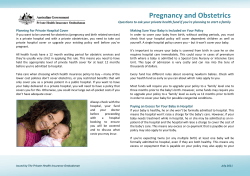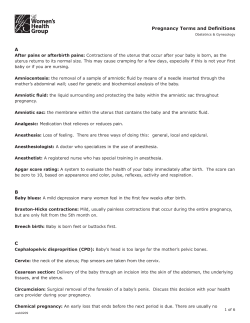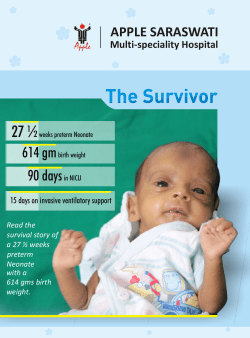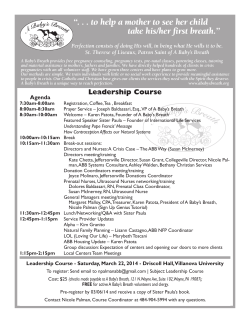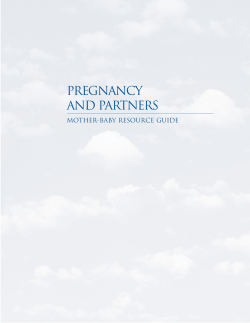
I HypnoBirthing One couple’s story...
HypnoBirthing by Jinty Kelly & Sally Lindberg TransformBirth www.transformbirth.co.uk One couple’s story... I n HypnoBirthing, mothers and their birth partners learn a series of selfhypnotic and relaxation techniques to enable mother and baby a more comfortable, natural birth experience, that is, one without the need for chemical or medical intervention. When practiced regularly, these techniques become second nature, instilling confidence in the mother and partner. Most women’s bodies are designed to carry babies and give birth. While there may be special circumstances which necessitate medical intervention, for the majority a natural birth can be a reality. HypnoBirthing aims to move away from purple pushing and panting and return women to what they were designed to do - give birth naturally! Their story For Hannah and Matt* the birth of their first child was a long and most traumatic experience, resulting in an emergency Caesarean section. on the WEB @ www.abcmag.co.uk Check it out! there was no guarantee of a pain They were determined to enjoy free birth but in fact, I did not a natural birth this time. We need any pain relief at all during interviewed them following labour or birth, not the birth of their even a paracetamol. second child after I had sensation, attending a HypnoBirthing I could feel HypnoBirthing aims to move pressure but antenatal away from purple I certainly course. pushing and panting wouldn’t and return women describe it as Hannah, to what they pain. I kept ‘in how did you were designed the zone’ with hear about to do... the techniques we HypnoBirthing had learnt, feeling and what made 100% confident in them." you decide to do it? "Our friend had a baby using How did the HypnoBirthing and she had HypnoBirthing course an amazing birth story. It was help you? the talk of our social group and "Part of the course helped us to other friends had taken the deal with feelings from our last course too. I read a book about birth and overcome any anxieties HypnoBirthing, but didn’t feel confident in that alone. Matt and we had around this birth so I talked about attending a course and then co-incidentally he met Jinty from TransformBirth. When our first child was born, we ended up having an emergency C-section which left us quite traumatised. We wanted to do it differently this time." we could really look forward to it. Sally and Jinty made it feel very relaxed and comfortable. Combined with learning and practicing specific techniques for breathing, self-hypnosis and relaxation, I felt totally empowered and confident during the birth." How did your medical team respond to you doing HypnoBirthing? "Our consultant wanted us to come into hospital but was open to the idea of the HypnoBirthing approach and even wrote it in our notes! Our midwives were very respectful and all communication went through Matt. Monitoring was minimal and Matt was able to pick up on my surges and communicate that to the midwife. (continued over the page) People usually expect that pain is a natural part of giving birth. What was your experience? "I was aware of the surges (contractions) walking from the car. We were told on the course ABC MAGAZINE - SUSSEX 127 (continued from previous page) Our midwife was quite firm with noisy medical staff when they came in, asking them to be quieter!" What about you Matt? What was your experience? "HypnoBirthing is the way birth is meant to be. I felt prepared and had a role. I tried to practise the techniques regularly and felt ready. The relaxation was good for us both and the baby. Reading the book provided alongside the classes made sense. The difference between this birth and the first birth was vast, eleven hours total in labour (only three active), as opposed to eighty four hours last time! HypnoBirthing - does what it says on the tin!" So Hannah, in summary, did HypnoBirthing work? "Yes, definitely. It completely transformed my experience of a painful first birth and feeling like a victim, to enjoying it the second time as something beautiful, bringing a child into the world. It was one of my proudest achievements and HypnoBirthing made it possible. We tell everyone what a dramatic change it was from first to second birth, and have recommended HypnoBirthing to friends. I think the course works even if you are sceptical, as it addresses so many different aspects of preparing for birth with plenty of opportunity to practise and ask questions along the way." HypnoBirthing, the Mongan Method was developed by an American mother of four, using her personal and professional experience to create a complete and unique antenatal course. She incorporated the work of an English obstetrician who observed that women giving birth without fear were relaxed and gave birth more easily, often without intervention. His theory, the ‘Fear-Tension-Pain Syndrome’ underpins much of the HypnoBirthing philosophy. HypnoBirthing is practised in more than twenty two countries. Midwives are increasingly embracing this natural approach and the NHS has undertaken a large-scale study. Mothers wishing to transform their birthing experience can now do so with HypnoBirthing. BAC *The couple’s names have been changed. Jinty Kelly DipHypPsych & Sally Lindberg DipHypPsych, co-founders of TransformBirth, are registered Hypnotherapists and HypnoBirthing Practitioners based in Brighton and Hove. They provide group and individual classes. www.tranformbirth.co.uk info@transformbirth.co.uk ...what Sussex parents really read! Placenta encapsulation F or centuries the benefits of Placentophagy (placenta consumption) have been known throughout the world and after a long disappearance, the tradition came back to the modern World in the 1970’s with the homebirth movements, especially in the USA. Regardless of the remedy you choose and the type of birth you had, your (and your baby’s) placenta can support you with five major concerns: Iron and recovery from blood loss in labour and birth: Blood loss in childbirth is natural, but with it comes a drop in iron levels and fatigue that we accept as being the norm. Consuming the placenta helps recovering part of the blood lost by providing high levels of iron necessary to the balance of hemoglobin and balance of the metabolism. Avoiding the 'baby blues' and reducing the risks of post-natal depression: After the 'birth high', women often find that their mood suddenly 128 ABC MAGAZINE - SUSSEX drops two days after the arrival of their babies, regardless of their personal circumstances - feeling teary, sad, anxious or jumpy are a normal part the immediate post-natal hormonal imbalance. This is partly due to the lack of vitamin B6 (nervous system and metabolism) and of the hormone CRH, which controls and reduces our levels of stress. Most pregnant women will feel light and relaxed in the last few weeks of their pregnancies, this is because CRH is produced in great quantities in the placenta, as it grows throughout the pregnancy. Consuming the placenta straight after the birth and throughout the post-natal recovery period (around six weeks) can allow the body to metabolise these missing links and may even entirely prevent this dark time. Milk production: IPEN testimonial records show an increase in milk supply and in some cases engorged breasts withing hours of taking placenta capsules for breast feeding mums. Testimonials also show a reduction in lactation-related infections such as mastitis... Energy levels: The blend of hormones, enzymes, nutrients and vitamins found in the Placenta can contribute to a faster physiological healing and recovery from labour and birth, as well as maintaining a hormonal balance favorable to a general feeling of well being in the weeks following the arrival of baby into the world. For further details please see www.aequa.co.uk
© Copyright 2025


